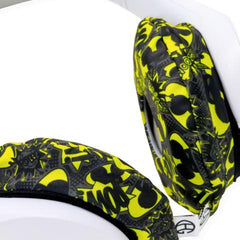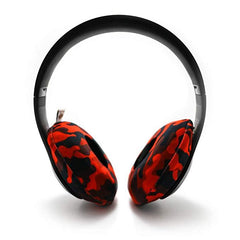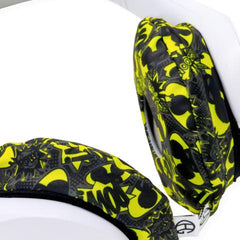Working Out with Noise-Cancelling Headphones: The Top 5 for the Gym

You've heard the term but what exactly are noise-cancelling headphones, and how do they work?
Flying to Europe in 1978, Amar Bose was offered a pair of in-flight headphones. He used them but quickly realised they were no good; he could barely hear the music over the sound of the engines and the more he dialled up the volume to compensate, the poorer the audio quality became. Surely, he thought, there has to be a way to fix this and, grabbing a handful of napkins, he started scribbling ideas and designs. On his return from Europe, he set up the Noise Reduction Technology Group at Bose to find a solution, and in 1986 the first noise-cancelling prototype was used. The headphones became commercially available in 1989.
What Types of Noise-Cancelling Are There?
There are two types of noise cancellation: passive and active.
Passive noise-cancellation is cheaper to buy and easier to explain. The headphones are padded with a material (a dense foam, for example) that helps to absorb noise, making it harder for sounds to reach the ear.
Active noise cancellation is more proactive at reducing outside noise. Using microphones to pick up external ambient sounds, the headphone creates its own sound waves that can then intercept the incoming noise and block it.
Even if you've never used noise-cancelling headphones, you've probably been in Bose's situation: you're trying to listen to a song or video but find the sounds of the outside world bleeding into it. You're probably guilty of turning up the volume, too, which, whilst understandable, can lead to permanent hearing loss over time. In situations like these, noise-cancelling technology is ideal for blocking low-frequency sounds like engines, street noise or chatter. Noise cancelling headphones are frequently used on airplanes, on public transport, in open-plan offices and, of course, in the gym if you're using EarHugz.

Noise Cancelling Headphones in the Gym
There are people who use noise-cancelling technology without music. They just put the headphones on, turn-on the noise-cancellation and go about their day. People use it in the gym for similar reasons: a quiet space to exercise in.
Noise causes stress.
Continual noise can have detrimental health effects, too. It's also a distraction, and if you're concentrating on your form, you don't want your brain competing with other sounds.
Gyms can be noisy places, and you don’t want to be dialling up the sound to mask the other loud sounds around you.
But headphones alone aren't ideal in the gym.
Sweat isn't good for their cushioning or for the electronics inside. You've probably been told to leave your headphones in your locker, and there are plenty of people with busted Beats or Bose's to testify that a hard workout can wreck an expensive set of cans.
Maybe that's why you switched to a cheaper pair. Maybe that's why your ears ring after each session. You can workout in noise-cancelling headphones BUT you have to protect them with EarHugz. EarHugz is sweat-resistant, machine washable, anti-bacterial headphone covers in a range of designs and colours. They'll protect your noise-cancelling headphones from sweat damage.
Top 5 Noise Cancelling Headphones
Sony WH-1000XM2
When the first iteration of these headphones was released a few years back, they had everyone talking, impressed at what Sony had done to close the gap on Bose. Released a year later, the MDR 1000 MX2 builds on this popularity with an impressive set of features ideal for life both inside and outside the gym. TechRadar describes them as 'the best noise-cancelling headphones on the planet...even better than the Bose QuietComfort 35'.
Thanks to Sony’s auto-setting, these headphones use accelerometers to detect motion so it knows if you’re walking, sitting still or on moving transport. They’ll then dial up or dial down the ambient noise cancelling function accordingly. You can control the settings via an app, too, choosing stable connections over sound quality if there’s something interfering with your WiFi or if there’s poor signal.
The battery is impressive, too, with 30 hours for wireless or 40 if you’re wired.
Similar to Beats there’s a useful quick charge function: 10 minute’s juice can give you an hour of battery.
Bose QuietComfort 35 II
Obviously, Bose is synonymous with noise-cancelling technology, so it would be remiss to leave them off this list. Some audiophiles swear by Bose and others will say their quality is overrated. But we think the QuietComfort 35 II has some very attractive features and now with the addition of Google Assistant it’s easy to check messages, to make calls or even ask about the weather without having to pause between exercises.
They're super comfortable, too, making them ideal for longer workouts.
The cups are thickly padded, cutting out a lot of ambient noise even when the noise-cancellation is turned off. This is perfect for when you need to save battery, and unlike other noise-reducing cans, these are pretty light.
Sennheiser Momentum Wireless 2.0
Sennheiser has been making headphones since 1945, but the Momentum Wireless Headphone 2.0, released in 2015, has been one of their most popular. These on-ear headphones offer clean and sharp audio in an attractive black leather design. The active noise-cancelling technology – NoiseGard – cuts out low-frequency background noise creating a space to think during your workout.
Tap the right ear cup to change tracks, adjust the volume or use the call settings without breaking stride. With fourteen hours between charges, you'll be set for any session, and their collapsible frame makes them really easy to travel with.
Bowers & Wilkins PX
Winners in the category for Best Wireless Headphone over £300 at the What HiFi Awards 2017, the Bowers-Wilkins PX look superb in navy blue with gold accents. An intuitive headphone. The PX is ideal for the gym: put a pair over your ears and they’ll switch on, lift a can up, take them off entirely and the music will pause. Put them down for a few minutes, they’ll go into standby mode to save power.
The PX comes with a number of useful noise-cancelling modes including the option to block out specific types of ambient noise including voices and aircraft.
You’re looking at about 22 hours of battery life with noise-cancellation and Bluetooth switched on. Turn off the bells and whistles, however, and you’ll get an impressive fifty hours of wired listening.
Beats Studio3 Wireless
Beats can be a controversial addition to any list regarding sound quality. Certainly, the anti-noise cancellation (ANC) is better in other headphones BUT Beats has made some ground since it was acquired by Apple. Even Tech Radar concede that the ANC is decent enough not to need an increase in volume in noisy environments.
If you're already into the Beats brand, then that's probably going to be good enough for you. And thanks to Apple's W1 chip, Beats Solo3 Wireless has an impressive 50-hours of play between charges. On top of that (and what we love) is that a three-hour charge can be done in five minutes making them perfect for those last-minute gym sessions.
If you're already an Apple user, then you'll enjoy seamless connectivity across multiple iOS devices.
Slightly less techie (but useful nonetheless), is the rubber headband which will keep the cans steady against your ears no matter how much.

Noise cancelling headphones are a fantastic addition to any workout BUT remember to protect them with a pair of EarHugz. Don't let sweat damage be the reason you have to buy another pair.



